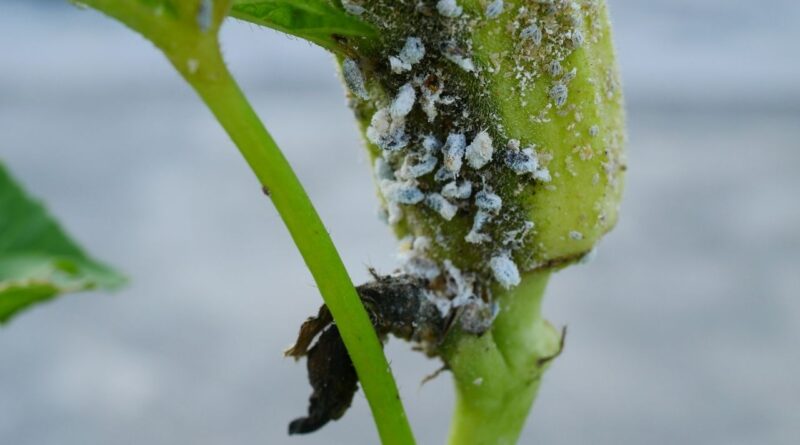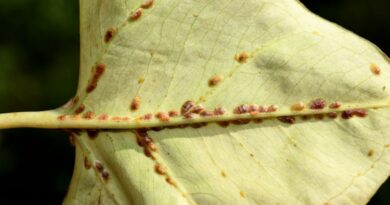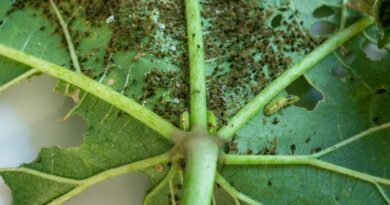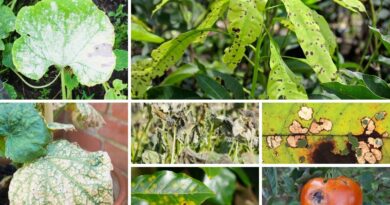A Basic Guide To Mealybugs
Mealybugs are soft-bodied, wingless insects that often appear as white cottony masses on the leaves, stems and fruits. They feed by inserting long sucking mouthparts into plants and drawing sap out of the plant tissues. Mealybugs are closely related to soft scales but lack the scale covers. They are usually found feeding in colonies in protected areas such as under leaves, stem crevices and in between fruits. Many woody ornamentals and many types of perennials plants are affected by mealybugs. There are approximately 275 species of mealybugs in the world. The most common species of mealybugs within Africa include;
– Kenya mealybug which attacks coffee, yam, pigeon pea, passion fruit, sugarcane and sweet potatoes.
– Pineapple mealybug which attacks pineapple, avocado, banana, celery, citrus, clover, cocoa, coconut, coffee, custard apple, figs, ginger, guava, maize, mango, oil palm, orchids, groundnut, peppers, plantain, potato and sugarcane.
– Striped mealybug is common on many plants.
– Pink sugarcane mealybug mainly attacks sugarcane and occasionally sorghum, rice and other grasses.
– Citrus mealybug attacks plants such as cocoa, bananas, tobacco and coffee.
– Long-tailed mealybug are commonly found on citrus, taro, avocado, guava, eggplant and grapevine.
– Mango mealybugs mainly attack mango and citrus plants.
– Cassava mealybug which attacks cassava.
Plants growing indoors or in greenhouses are especially vulnerable because year-round mild temperatures favor mealybug populations and these plants are usually not exposed to the natural predators that keep mealybugs in control outdoors.
Identification
Mealybug bodies are distinctly segmented and usually covered with a white or grey mealy wax. Adult mealybugs may have wax filaments around their body margins. In some species the filaments are longer in the rear and can be used to help distinguish between different species. The small nymphs, called crawlers, are light yellow and free of wax. They are active at their early stages but move little once they find a suitable feeding site. While adult females are wingless and similar in shape to the crawlers, adult male mealybugs are tiny two-winged insects with two long tail filaments.
Lifecycle
The lifecycle of mealybugs varies somewhat by species. Adult females of most mealybugs lay between 100 to over 200 eggs over a 10-20-day period. Egg sacs may be attached to crowns, leaves, bark, fruit or branches. The longtailed mealybug produces eggs that remain within the female until they hatch. Hatching occurs within 1-3 weeks. Newly hatched nymphs (crawlers) are yellow to orangish or pink. They are very active but they begin to excrete a waxy covering soon after settling down to feed. Older nymphs and adults have legs and they can move but they don’t move very far or very rapidly. Nymphs molt through several instars before becoming adults. Female nymphs pass through three instars while male nymphs pass through five instars. Male nymphs stop feeding after the first two instars and exist solely to fertilize the females. Male mealybugs are rarely seen since many mealybug species can reproduce asexually, without mating. Where climates are warm or plants are growing indoors, all stages may be present throughout the year.
What does mealybug damage look like?
Heavy mealybug attacks appear as white, waxy masses of mealybugs on stems, fruits and along the veins on the underside of leaves. The adults and nymphs cause damage to host plants by sucking the sap and removing nutrients. Mealybugs can attack roots, tender leaves, petioles and fruits. Pay special attention to new growth, leaf undersides and leaf joints. As a result, plants often become stunted, distorted or yellowed and show reduced vigour. Severely infested leaves turn yellow and gradually dry. Severe attack can result in shedding of leaves and flower, reduced fruit setting and shedding of young fruits. Feeding on fruit results in discoloured, bumpy and scarred fruit. They excrete honeydew which provides a medium for the growth of black sooty mould. Black sooty mould covers leaves thus reducing photosynthesis and inducing plant stress. Mealybugs are sometimes confused with other pests that produce waxy coatings, honeydew and black sooty mould, including woolly aphids, whiteflies and some soft scales. Carefully examine the insect beneath the wax to identify it properly.
Control and prevention
Early detection of mealybugs is vital for effective control. Prevention and control should always start from physical methods before resorting to using any chemicals. It is best to always avoid synthetic pesticides.
- In low infestations, mealybugs can be picked off from affected plants.
- Infected parts can be pruned off and destroyed. If a plant is heavily infested, it should be removed and destroyed.
- Mealybugs can be knocked off host plants using a stream of water with high pressure. This reduces their population because the fallen mealybugs are exposed to ground predators therefore they cannot return to the plants easily.
- Maintaining healthy plants. Healthy plants can tolerate low populations without significant damage. In some cases, it has been reported that improved nutrition in plants also promotes the activity of natural enemies of mealybugs which keep their population in check. However, avoid overfertilizing your plants because mealybugs are attracted to plants with high nitrogen levels because it promotes a lot of soft leafy growth.
- Companion planting, especially with flowering plants helps to attract the natural predators of mealybugs such as ladybirds, hoverflies and lacewings.
- Controlling the ants which usually accompany mealybug infestations. These ants feed on the honeydew that mealybugs produce and protect the bugs from their enemies to ensure this food supply. Ants can be controlled by either destroying their nests or by excluding ants from the plant by applying a grease barrier around the stems or trunks of the plants.
- Spot spraying using insecticidal soap or soapy solution made from organic liquid soap.
Mix 1 tablespoon of organic liquid soap with 1 litre of water. Apply on the infested plants thoroughly including the undersides of leaves, new growth and leaf joints. Spray every 3 to 5 days depending on the level of infestation for better efficacy. Do not use washing detergents.
- Neem oil disrupts the growth and development of mealybugs. It has both repellent and antifeeding properties on the pests. Crawlers are the easiest to kill since they are more susceptible and are more exposed than eggs, older nymphs and adults. As they grow the wax covering their bodies becomes thicker making them more resistant to insecticides
When using soap solution and neem oil, good timing is important to avoid harming pollinators and other beneficials and also spraying when the sun is hot may cause leaf scorching. Spray early in the morning or late afternoon. Make sure your plants are well-watered before spraying, do not spray wilted plants.
Neem oil foliar spray
– Fill your spray bottle halfway.
-Mix 1 teaspoon (5ml) of neem oil and 1 teaspoon (5ml) of organic liquid soap into the water.
– Fill up the bottle to the 1 litre mark.
-Shake well then spray.
-Spray the plant thoroughly especially under the leaves and joints.
When using neem oil on flowering plants, avoid spraying the flowers themselves. For food crops do not spray on the day of harvest. Give your plants at least 48 hours before harvesting. The spray can be reapplied after 14 days for mild infestations. In case of heavy infestation, it should be reapplied every 7 days for about 4 weeks.
Neem oil soil soak
Soil soak or drench works best on larger outdoor plants that are difficult to spray. It can last up to 22 days before needing another application. The plants will soak up the neem mixture and it will poison any pest that tries to feed on the plants. This method is very safe and effective because pollinators or other beneficial insects cannot be harmed. Use the soak when there is no rain so that the neem won’t be dispersed before being absorbed.
-Mix 1 teaspoon of the soap into 1 litre of water and stir.
– Add 2 tablespoons of neem oil to the water.
– To apply, pour a fair amount of the mixture onto the soil around the target plants. Cover a wide enough radius to feed most of the roots. About 2 to 4 cups for average size indoor/outdoor plants. More is required for trees and larger shrubs.




